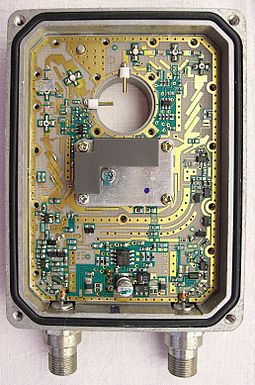 | ||
 |
A distributed-element filter is an electronic filter in which capacitance, inductance, and resistance (the elements of the circuit) are not localised in discrete capacitors, inductors, and resistors as they are in conventional filters. Its purpose is to allow a range of signal frequencies to pass, but to block others. Conventional filters are constructed from inductors and capacitors, and the circuits so built are described by the lumped element model, which considers each element to be "lumped together" at one place. That model is conceptually simple, but it becomes increasingly unreliable as the frequency of the signal increases, or equivalently as the wavelength decreases. The distributed-element model applies at all frequencies, and is used in transmission-line theory; many distributed-element components are made of short lengths of transmission line. In the distributed view of circuits, the elements are distributed along the length of conductors and are inextricably mixed together. The filter design is usually concerned only with inductance and capacitance, but because of this mixing of elements they cannot be treated as separate "lumped" capacitors and inductors. There is no precise frequency above which distributed element filters must be used but they are especially associated with the microwave band (wavelength less than one metre).
Distributed-element filters are used in many of the same applications as lumped element filters, such as selectivity of radio channel, bandlimiting of noise and multiplexing of many signals into one channel. Distributed-element filters may be constructed to have any of the bandforms possible with lumped elements (low-pass, band-pass, etc.) with the exception of high-pass, which is usually only approximated. All filter classes used in lumped element designs (Butterworth, Chebyshev, etc.) can be implemented using a distributed-element approach.
There are many component forms used to construct distributed-element filters, but all have the common property of causing a discontinuity on the transmission line. These discontinuities present a reactive impedance to a wavefront travelling down the line, and these reactances can be chosen by design to serve as approximations for lumped inductors, capacitors or resonators, as required by the filter.[4]
The development of distributed-element filters was spurred on by the military need for radar and electronic counter measures during World War II. Lumped element analogue filters had long before been developed but these new military systems operated at microwave frequencies and new filter designs were required. When the war ended, the technology found applications in the microwave links used by telephone companies and other organisations with large fixed-communication networks, such as television broadcasters. Nowadays the technology can be found in several mass-produced consumer items, such as the converters (figure 1 shows an example) used with satellite television dishes.